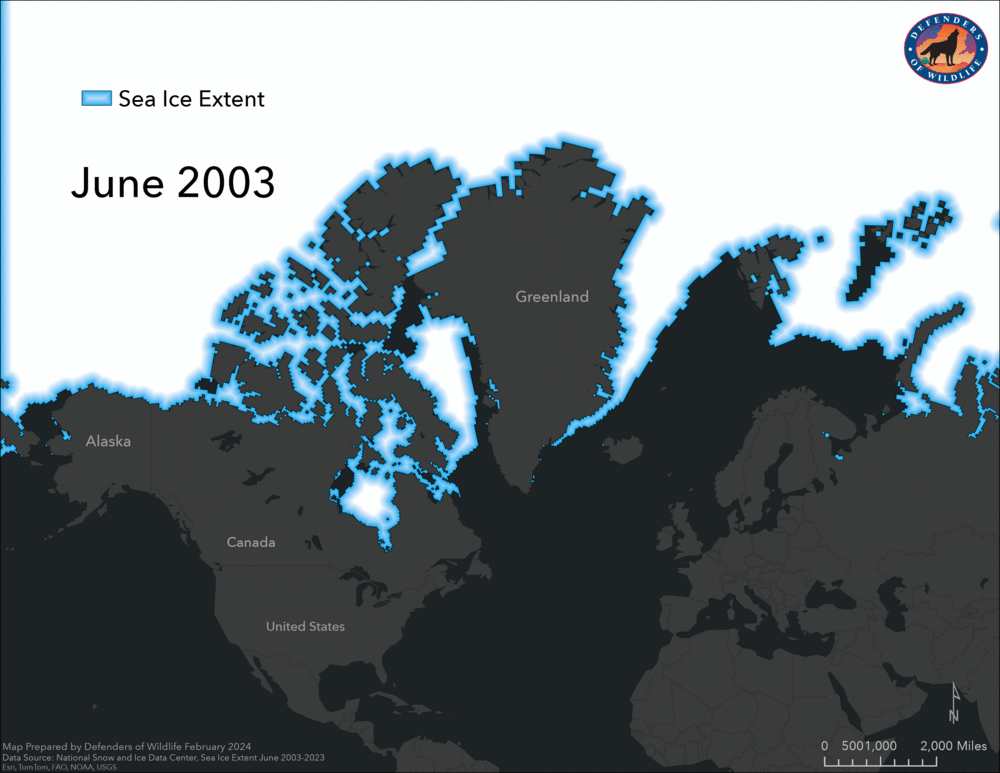There’s a shift in the scenery. The icy seascape that once dominated the Arctic year-round is melting and thinning before our eyes with rising global temperatures. Seals and polar bears relying on this critical habitat are forced to adapt quickly or die trying.
In Alaska, the arrival of spring brings newborn polar bear cubs emerging from their snow dens for the first time with their moms. Mother bears then embark on long, harsh hunts in search of their favorite food. These hunts need to be successful so these moms can support their cubs and endure a fasting period during the warmest months when the ice is further from land, making hunting even harder.
With sea ice changing from year to year, the food availability and a bear’s traditional ways of hunting on ice are also shifting.
Where Do Polar Bears Live?
Like many predators, polar bears live where they have the best access to their food. Polar bears have evolved to rely on sea ice to hunt seals, their primary prey. Seals provide these bears with substantial fat to survive severe Arctic conditions. Adult bears will hunt for and store approximately two-thirds of their energy in the late spring and early summer. Then they will fast for potentially 100 or more days during the warmer months, waiting for the ice to return, bringing back the ability to hunt again.
As sea ice decreases, polar bears spend more time on land without the same access to the typical seal diet which they have historically relied on. This causes them to fast for longer periods, affecting their behavior, health and reproductive success.
Polar bears mate in the spring when they are out on the sea ice, but this doesn’t occur until male bears are eight to ten years of age and females are four to five years old. When a female bear mates successfully, the embryo goes through a process called delayed implantation. During this stage, the fertilized egg stops growing for 4 months so the mother can build up enough energy and fat content to birth and nurse her cubs during the long winter. If a female lacks sufficient fat reserves during the spring and summer, the fertilized egg will not implant. Like other bears, polar bears have slow reproduction rates so additional hindrances can have detrimental, long-term effects on population numbers.
Sea Ice Outlook
Arctic sea ice was historically present near land, even during the warmest summer months. Because of climate change, the decrease in summer ice is now so extreme that some models show a risk of most of the Arctic experiencing an ice-free summer by 2040. Sea ice currently is retreating earlier in the spring and advancing later in the fall, meaning the bears’ fasting period will continue to grow longer and longer.
This change in sea ice availability also forces bears to make a choice each spring: will they stay on land with limited food, or will they swim far distances to reach ice? Both choices come with risks. Staying on land increases the chance of conflicts with people, while the distance to reach huntable ice is growing from 100 miles to well over 200 miles.
Save the Polar Bears
The future polar bears face if we do nothing to combat climate change and human impact, is nothing short of tragic – but it’s not hopeless. We must reduce carbon emissions and stop oil and gas development, like the Willow Project, in this pristine environment and protect habitat for arctic wildlife so that these magnificent animals can escape extinction.
You can make a difference in your everyday life by paying attention to the brands you support. For example, buying local produce helps reduce the emissions needed to get food from the farm to your table. You can also support organizations, like Defenders of Wildlife, who are fighting for lower carbon emissions, and oil and gas development in the arctic.
Defenders is in court to stop the Willow Project, which threatens denning polar bears directly and will pump more than 250 million tons of greenhouse gases into the atmosphere. But we can’t do it alone. Join us today in fighting to save polar bears and more by telling the Biden administration to shut down the Willow oil drilling plan.










